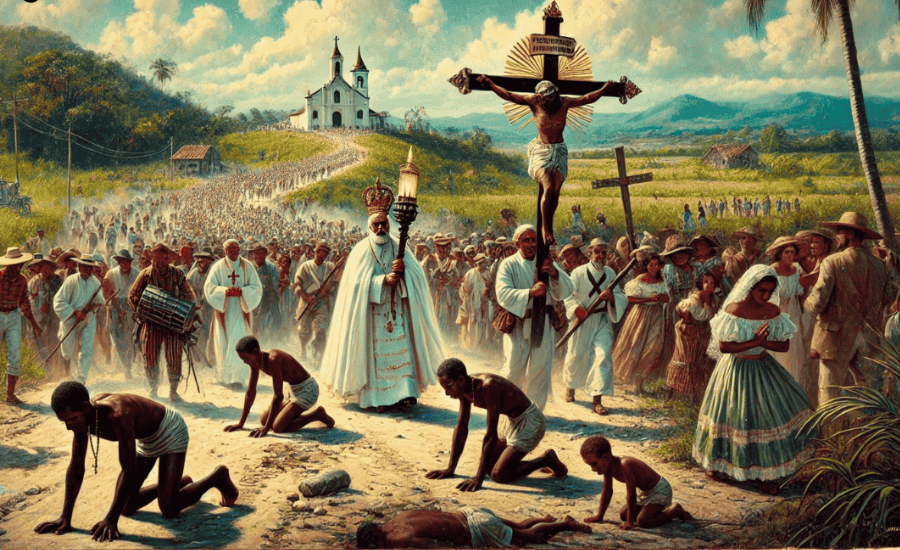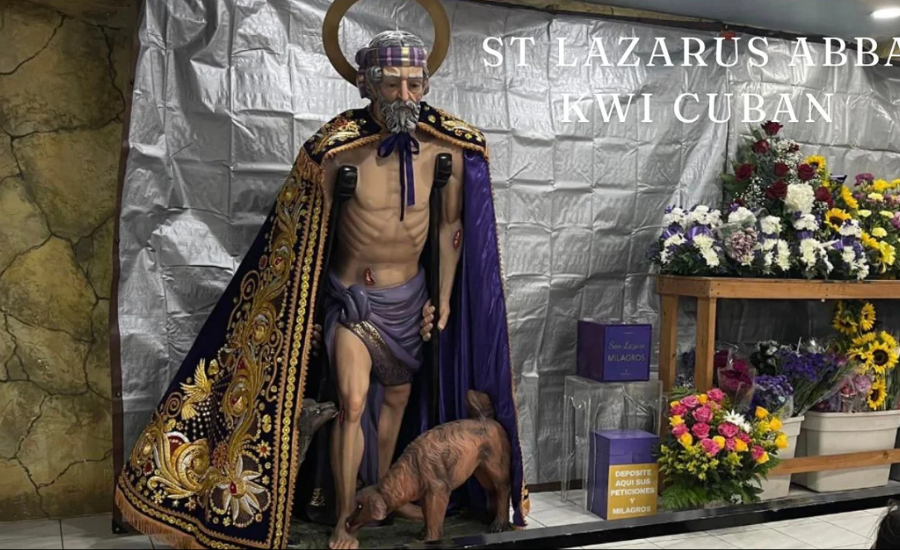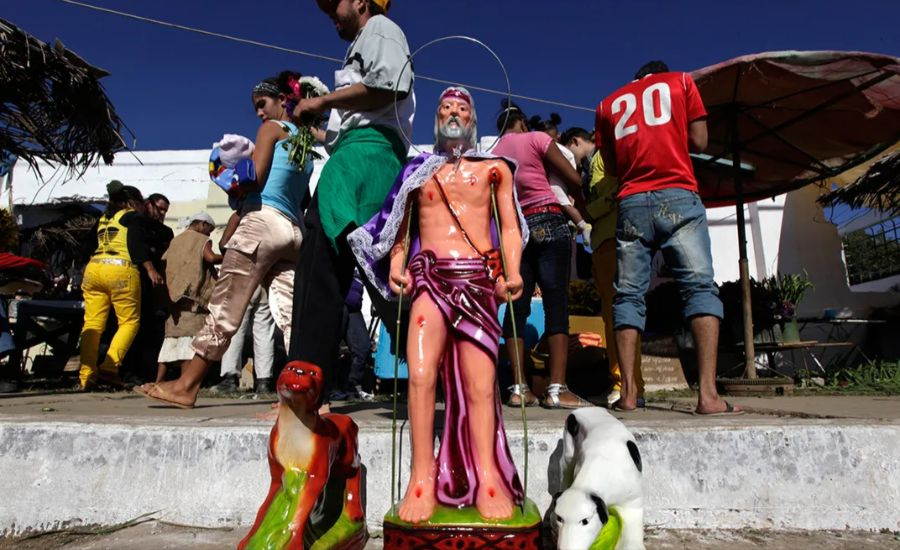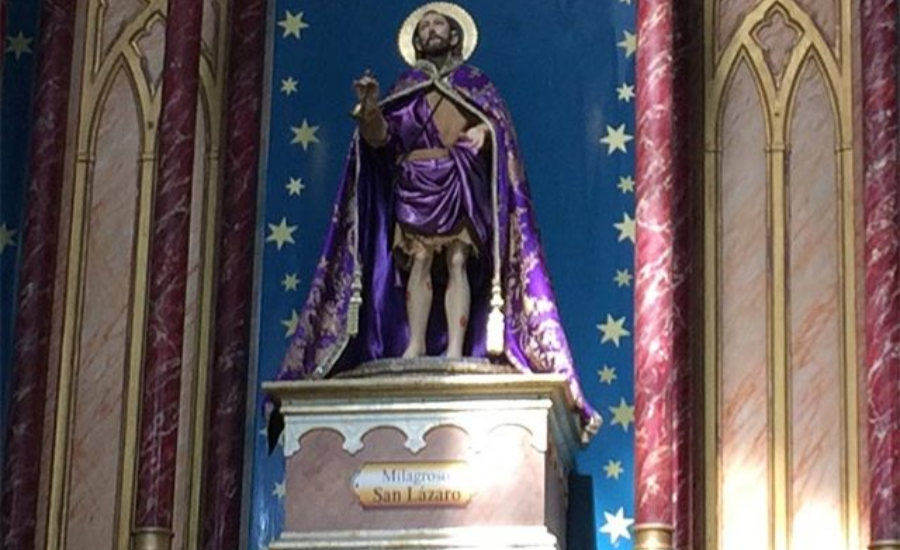ST Lazarus Abba Kwi Cuban: The Intersection of Healing and Faith in Cuban Culture
St lazarus abba kwi cuban, also known as Abba Kwi in Afro-Cuban spirituality, stands as a prominent figure at the intersection of Christian belief and Afro-Cuban traditions. This revered saint embodies rich layers of spiritual meaning, serving as a bridge between diverse cultural practices.
His significance in Cuban culture is deeply rooted in the intertwining of Catholicism and African religious practices, reflecting a vibrant tapestry of faith that resonates with many. St. Lazarus is often called upon for healing and protection, showcasing his role as a protector of the marginalized and a symbol of hope. This duality of spiritual importance highlights the complex cultural landscape of Cuba, where different traditions coexist and enrich one another.
Through the rituals and celebrations honoring St. Lazarus, the Cuban community expresses its devotion, connecting the past with the present and fostering a sense of collective identity. The convergence of these beliefs illustrates how tradition and faith intertwine, shaping the lives of many in profound ways.
st lazarus abba kwi cuban: Symbols of Hope and Justice

Lazarus of Bethany, prominently featured in the Gospel of John, is renowned for his miraculous revival by Jesus after being dead for four days. This powerful event underscores themes of faith and the extraordinary nature of divine intervention, demonstrating how belief can transcend the boundaries of life and death.
In contrast, the character of Lazarus in the Gospel of Luke represents a different narrative. Known as the Destitute Hobo Lazarus, he is depicted as a suffering man who faces hardship in his earthly life. However, his story offers a message of hope, revealing that he finds solace and peace in the afterlife, serving as a poignant reminder of justice and compassion. His plight starkly contrasts with that of a wealthy man who neglects him, emphasizing the moral lesson that earthly status does not determine one’s worth or fate.
Together, these two portrayals of Lazarus enrich the biblical narrative, highlighting essential themes of resilience, faith, and the eternal significance of how we treat others.
St. Lazarus: A Pillar of Santería in Cuba
In Cuba, St. Lazarus, known as Abba Kwi, transcends his biblical origins to become a pivotal figure in Santería, a syncretic faith that merges Catholicism with Yoruba traditions. In this spiritual framework, he is often associated with Babalu Aye, an orisha revered in Yoruba belief for his connection to illness, healing, and compassion.
This fusion of beliefs highlights the rich cultural tapestry of Cuba, where various religious practices coexist and influence one another. St. Lazarus’s role in Santería symbolizes not only the power of healing and protection but also the profound empathy and care that underpin the faith. His presence in rituals and celebrations serves as a testament to the resilience of cultural identity, illustrating how historical and spiritual narratives can evolve and adapt over time. Through this unique blend of traditions, St. Lazarus embodies hope and healing, resonating deeply within the hearts of those who honor him.
St. Lazarus: A Symbol of Hope and Resilience
In Cuban culture, St. Lazarus, or Abba Kwi, embodies a powerful image of hope and resilience. Far beyond being merely a religious figure, he represents the enduring spirit of the Cuban people. His association with perseverance and healing resonates deeply with individuals who have faced adversity, especially within marginalized communities. For many, St. Lazarus serves as a beacon of trust and strength, inspiring confidence in the face of life’s challenges.
The Pilgrimage to El Rincón
A significant spiritual event in Cuba is the pilgrimage to El Rincón, near Havana, celebrated annually on December 17th. This revered occasion attracts thousands of devotees from across Cuba and beyond, marking a profound expression of faith and commitment. Participants engage in various acts of devotion, such as crawling for miles as an expression of penance, carrying heavy crosses as a sign of sacrifice, and lighting candles or placing flowers at altars as tokens of their dedication.
This pilgrimage beautifully weaves together Christian and Afro-Cuban elements, reflecting the rich tapestry of Cuba’s spiritual heritage and highlighting the communal nature of worship.
Everyday Devotional Practices
Many Cubans maintain a personal connection with St. Lazarus through daily or weekly rituals performed at home altars. Common practices include lighting candles to seek blessings or healing, offering flowers and herbs as symbols of reverence, and presenting food offerings, such as roasted pork or fruits, that align with traditional Cuban cuisine.
Additionally, small statues of dogs, which are said to have licked Lazarus’s wounds, symbolize compassion and loyalty. These rituals underscore St. Lazarus’s role as an approachable and responsive figure, intricately woven into the daily lives of his devotees. Through these practices, he remains a source of comfort and strength, continually inspiring hope in their hearts.
St. Lazarus and Santería: A Spiritual Convergence
Babalu Aye’s Significance
In Santería, a vibrant religion that intertwines African Yoruba beliefs with Catholic traditions, St. Lazarus, known as Abba Kwi, is often associated with Babalu Aye, an orisha linked to illness and healing. This connection illustrates how Afro-Cuban spiritual practices fuse African spiritual traditions with Catholic symbolism, creating a rich tapestry of belief that reflects the cultural heritage of the region.
Rituals and Offerings
Devotees of Santería engage in specific rituals dedicated to Babalu Aye, which may include offerings of small animals as traditional sacrifices. Practitioners also participate in herbal baths for spiritual cleansing, invoking the healing powers of both Babalu Aye and St. Lazarus. Dance ceremonies, marked by vibrant drumming and movement, play a crucial role in these rituals, emphasizing the dynamic African influence that is central to Santería.
The Healing Influence of St. Lazarus

Seeking Healing and Protection
For many believers, St. Lazarus serves as a vital source of healing and comfort. The faith in his ability to address both physical and emotional struggles is deeply rooted in the community. Individuals often carry amulets or wear images of St. Lazarus as protective charms, hoping to repel illness and invite his healing presence into their lives.
Miraculous Accounts
The belief in St. Lazarus’s healing powers is further reinforced by countless personal testimonies of miraculous events. These narratives, passed down through generations, contribute to the enduring legacy of the saint. For many Cubans, these stories serve as confirmation that St. Lazarus is ever-present and ready to provide assistance in times of need, reinforcing the bond between faith and the everyday experiences of his followers.
Cultural and Spiritual Fusion in Cuba
Cuba’s vibrant cultural tapestry is beautifully reflected in its spiritual practices, notably through the veneration of St. Lazarus, or Abba Kwi. This figure symbolizes a fascinating blend of influences:
Interwoven Beliefs
The fusion of Christianity and African spirituality creates a unique religious identity that defines the Cuban experience. The integration of Catholicism and Yoruba traditions forms a rich spiritual landscape, showcasing how diverse beliefs can harmoniously coexist.
Syncretic Practices
The overlap between Catholic and Santería customs allows for a seamless blending of different faiths. This syncretism not only fosters mutual respect among practitioners but also enriches the cultural fabric of Cuba, providing a space for various spiritual expressions.
Evolving Traditions
As new generations reinterpret and adapt these spiritual practices, they continue to shape and expand Cuba’s otherworldly landscape. This evolution highlights the dynamic nature of belief systems, illustrating how they can grow and evolve over time.
Through this cultural amalgamation, Cuba demonstrates how different spiritual traditions can coexist and flourish together, creating a dynamic and inclusive religious experience that resonates deeply with its people.
St. Lazarus: A Beacon of Hope in Cuban Spirituality
St. Lazarus, revered as Abba Kwi in Cuban culture, occupies a cherished position in the hearts of many. His figure resonates profoundly within both Afro-Cuban spirituality and Catholic traditions, symbolizing the intersection of these rich belief systems.
Recognized for his associations with healing and protection, St. Lazarus embodies hope for those enduring hardship. Many devotees seek his intercession during times of illness or struggle, trusting in his miraculous abilities to provide solace and support.
The presence of St. Lazarus is widespread across Cuba, with statues and altars adorned with vibrant flowers found in both homes and public spaces. These representations serve as tangible reminders of faith and resilience, illustrating the enduring impact of his legacy within the community.
Vibrant Celebrations of St. Lazarus
Celebrations in honor of St. Lazarus, known as Abba Kwi in Cuban culture, are lively and steeped in tradition. Each year on December 17th, devotees converge at the renowned El Rincón Sanctuary, where the atmosphere is filled with colorful offerings and heartfelt devotion.
Participants often wear white attire, signifying purity and reverence for the saint. Many arrive carrying candles and flowers, paying tribute to his revered healing abilities.
While rituals may vary among communities, they commonly feature music, dance, and earnest prayers. The rhythmic sounds of drumming fill the air, inviting worshippers to move together in joyous celebration.
A distinctive aspect of these festivities is the inclusion of pets, as attendees seek blessings for their animals’ health and protection. This unique practice underscores St. Lazarus’s deep connection with the animal world, further enriching the spiritual experience for all involved.
St. Lazarus: A Source of Healing and Hope
St. Lazarus, revered as Abba Kwi in Cuban culture, is celebrated for his remarkable miracles and healing powers. In times of dire need, countless devotees turn to him, seeking relief from ailments that seem beyond remedy.
Numerous stories highlight individuals who have experienced miraculous recoveries from chronic illnesses after offering fervent prayers or making offerings at his shrines. His healing influence is not limited to the physical realm; many find emotional comfort and peace through their unwavering faith in him.
Commonly depicted with a dog by his side, St. Lazarus symbolizes loyalty and companionship during challenging times. This imagery resonates profoundly with those seeking healing, reinforcing the bond between the saint and his followers as they navigate their struggles.
St. Lazarus: A Global Symbol of Faith

St. Lazarus, known as Abba Kwi in Cuban culture, has transcended his regional origins, resonating with many beyond Cuba. His influence can be felt in various communities throughout Latin America and even parts of Europe, where he is honored and revered.
In cities like Miami, which boasts a vibrant Cuban population, lively celebrations unfold each December 17th. Pilgrims gather in churches adorned with images of St. Lazarus, seeking his blessings and healing touch.
These rituals often blend Afro-Cuban religious traditions with Catholic practices, creating a rich cultural tapestry that deeply resonates within local communities. As awareness of St. Lazarus spreads through social media and cultural exchanges, more individuals are discovering his powerful story and significance.
Festivals celebrating St. Lazarus are emerging around the world, fostering connections among diverse groups united by shared faith and tradition, highlighting the enduring legacy of this beloved saint.
Also Read: Amanda Labollita
Final Words
St. Lazarus, known as Abba Kwi in Cuban culture, stands as a revered symbol of healing and hope, embodying the rich spiritual traditions that intertwine Afro-Cuban beliefs and Catholicism. Celebrated annually on December 17th, his vibrant festivals attract devotees seeking blessings and solace. At the El Rincón Sanctuary, attendees don white attire and bring offerings of candles and flowers, reflecting their devotion. St. Lazarus’s imagery often features a loyal dog, representing companionship during life’s struggles. Beyond Cuba, his influence extends to various communities across Latin America and Europe, where people celebrate his legacy through rituals that honor both spiritual healing and cultural identity. The profound connection to St. Lazarus, or Abba Kwi, illustrates the enduring spirit of those who seek his intercession in times of need, emphasizing the power of faith to foster resilience and unity in diverse communities.
For exclusive shoe discounts, don’t miss out on Buzz Revolve at Latest Drift.






